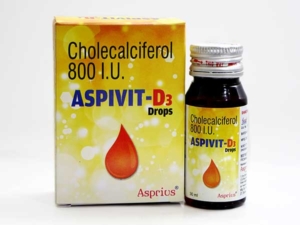
Dr. Sanjay Agrawal
Leading Pharmaceutical consultant and editor-in chief of IJMToday

People with overweight and obesity appear more likely to have low vitamin D levels, compared with people with weights falling within the “normal” body mass index (BMI) range. This has caused some to suggest that low vitamin D levels may cause weight gain.
Why do people with overweight or obesity often have lower vitamin D levels?
Currently, most researchers believe that the lower vitamin D levels observed in people with overweight or obesity may be explained by other factors.
For instance, since vitamin D is stored in fatty tissues, people with larger amounts of body fat may need greater amounts of vitamin D to maintain blood levels similar to those of people of lower body weights.
People with overweight or obesity may also spend less time outdoors, or eat less vitamin-D-rich or vitamin-D-fortified foods. Accordingly, experts suggest that people with overweight may need 1.5 times more vitamin D than individuals with BMIs in the “normal” range to maintain similar blood levels, whereas people with obesity may require 2–3 times more.
People with overweight or obesity often have lower vitamin D levels than people with BMIs in the “normal” range. Still, evidence to suggest that low vitamin D levels cause weight gain or make it more difficult to lose body fat is limited.
How to tell whether you have a vitamin D deficiency
Over time, suboptimal sun exposure or low amounts of vitamin-D-rich foods in the diet may cause you to develop a vitamin D deficiency.
Signs and symptoms of vitamin D deficiency
Vitamin D deficiency isn’t typically associated with noticeable symptoms unless the deficiency is severe, so most people don’t know they’re deficient until they have a blood test. However, prolonged, severe deficiency can result in the following symptoms
* Bone pain or deformities
* Rickets
* Seizures
* Muscle spasms
* Dental abnormalities
* Heart problems
If you recognize any of the above symptoms, make sure to discuss them with your healthcare provider to rule out a vitamin D deficiency.
People most at risk of vitamin D deficiency
Although a vitamin D deficiency can affect anyone, certain groups of people may be at a greater risk.
For instance, people who have had gastric bypass surgery may have a reduced ability to absorb vitamin D from their diet, which may put them at higher risk of developing a vitamin D deficiency. This also appears to be true for people with celiac disease, short bowel syndrome, inflammatory bowel disease (IBD), cystic fibrosis, or chronic pancreatic insufficiency.
Older individuals, as well as those who have darker skin tones or spend little time outdoors, may likewise have an increased risk of deficiency due to a reduced ability to produce sufficient vitamin D from sun exposure alone.
Furthermore, vitamin D deficiency is more common in people with obesity. Finally, certain prescription medications may accelerate vitamin D breakdown in the body, in turn, possibly increasing the risk of vitamin D deficiency.
Getting your blood vitamin D levels tested
If you suspect you may have low vitamin D levels, consider getting your blood levels tested to rule out a vitamin D deficiency.
Optimal blood levels tend to fall within the 30–100 ng/mL range. Values below 20 ng/mL are usually defined as a mild deficiency, and those below 10 ng/mL are considered a moderate deficiency. Vitamin D levels below 5 ng/mL are considered a severe deficiency. A proportion of health professionals recommend that you get your blood vitamin D levels tested twice per year — once in the spring and once again in the fall.
Doing so can help you evaluate your current vitamin D levels in relation to your sun exposure and tailor your vitamin D intake or supplement regimen accordingly.
People with a vitamin D deficiency may experience a range of symptoms. If you suspect you may have low vitamin D levels or fall in one of the at-risk categories, consider getting a blood test to rule out a deficiency.
Ways to improve vitamin D levels
There are many ways to improve your vitamin D levels.
Sun exposure
Your body can produce this vitamin from cholesterol when your skin is exposed to ultraviolet B (UVB) sun rays.
According to experts, exposing around 40% of your skin for at least 20 minutes to the midday sun, without wearing sunscreen, is sufficient for most people to produce enough vitamin D.
However, those with darker complexions or living more than 35 degrees above or below the equator may find it difficult to produce enough vitamin D from the sun alone. Smog levels, cloud cover, altitude, and the season are other influencing factors to consider. Moreover, most dermatologists warn against excess sun exposure due to the increased risk of skin cancer linked to excess UV radiation.
Diet and supplements



The reasons described above make it important to ensure you include vitamin-D-rich or vitamin-D-fortified foods in your diet. Some examples include fatty fish, mushrooms, fortified dairy- or plant-based milks, eggs, liver, and other meats. The reference daily intake (RDI) for vitamin D is currently set at 600 IU (15 mcg) per day for adults, and 800 IU (20 mcg) per day for people who are pregnant.
However, some experts argue that these recommendations are far too low to maintain optimal vitamin D levels.
If you’re unable to maintain adequate blood vitamin D levels through sunshine and diet alone, a supplement providing 800–4,000 IU (20–100 mcg) of vitamin D may be needed. Keep in mind that vitamin D is a fat-soluble vitamin, which means that taking excessive amounts over long periods may cause it to accumulate in your tissues up to levels that can be toxic.
Although vitamin D toxicity is rare, taking extremely high doses of vitamin D over prolonged periods may result in dangerous side effects. The most common cause of vitamin D toxicity is accidental overdose.
This can result in nausea, vomiting, muscle weakness, pain, poor appetite, dehydration, brain disturbances, heart and kidney problems, and in severe cases, even death.
The best way to avoid vitamin D toxicity is getting your blood vitamin D levels checked before and during supplementation, as well as working with your healthcare provider to adjust the dosage accordingly.
SUMMARY
You can improve your vitamin D levels through a combination of sun exposure, diet, and supplementation. Regularly monitoring your blood vitamin D levels can help you tailor your supplement regimen and reduce your risk of vitamin D toxicity.




